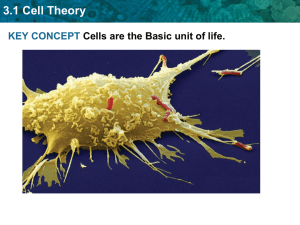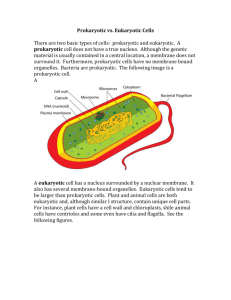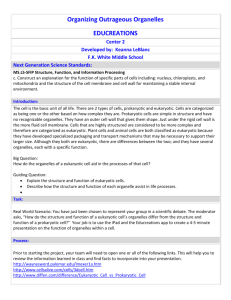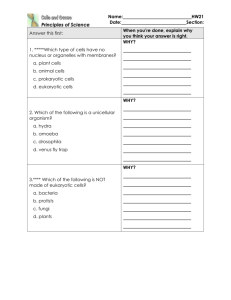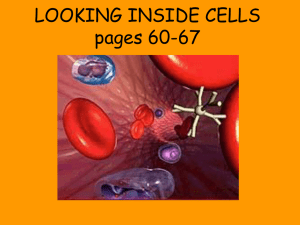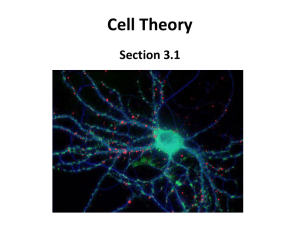Cells Investigation#2
advertisement
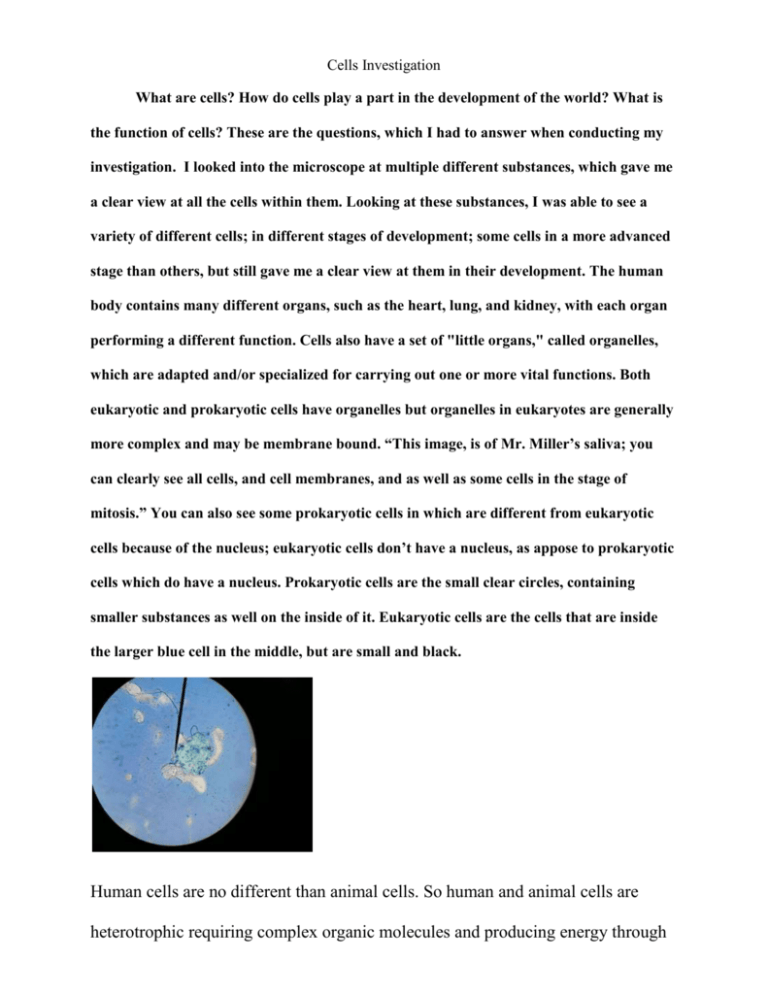
Cells Investigation What are cells? How do cells play a part in the development of the world? What is the function of cells? These are the questions, which I had to answer when conducting my investigation. I looked into the microscope at multiple different substances, which gave me a clear view at all the cells within them. Looking at these substances, I was able to see a variety of different cells; in different stages of development; some cells in a more advanced stage than others, but still gave me a clear view at them in their development. The human body contains many different organs, such as the heart, lung, and kidney, with each organ performing a different function. Cells also have a set of "little organs," called organelles, which are adapted and/or specialized for carrying out one or more vital functions. Both eukaryotic and prokaryotic cells have organelles but organelles in eukaryotes are generally more complex and may be membrane bound. “This image, is of Mr. Miller’s saliva; you can clearly see all cells, and cell membranes, and as well as some cells in the stage of mitosis.” You can also see some prokaryotic cells in which are different from eukaryotic cells because of the nucleus; eukaryotic cells don’t have a nucleus, as appose to prokaryotic cells which do have a nucleus. Prokaryotic cells are the small clear circles, containing smaller substances as well on the inside of it. Eukaryotic cells are the cells that are inside the larger blue cell in the middle, but are small and black. Human cells are no different than animal cells. So human and animal cells are heterotrophic requiring complex organic molecules and producing energy through cellular respiration. Additionally, animal cells have centrioles and may have cilia or flagella. During mitosis, the cytoplasm of the cell is divided by formation of a cleavage furrow. Animal cells tend to be smaller than human cells. This is a photo of a snail that we took out of Mr. Miller’s fish tank. As you can clearly see the snail is not showing any cells, at this magnification. Even though you can’t see any of the cells, they are almost exactly the same as those of Mr. Miller’s cheek. Animal cells are like a eukaryotic cell, but have a plasma membrane and organelles. are one of the structurally complex cell type, and by definition are in part organized by smaller interior compartments, that are themselves enclosed by lipid membranes that resemble the outermost cell membrane. Animal and plant cells have some similarities and differences. Understanding basic cell structure helps to understand how plant cells differ from animal cells. Both animal and plant cells have some similar structural elements. First off they are both eukaryotic, which means they have a defined nucleus. The nucleus contains chromosomes. It is protected and covered by the cytoplasm; which is a watery or gel-like liquid. Further, animal and plant cells have a cell membrane that covers the cell. This lets the cell exert control, in most cases, over what can penetrate the cell, and what cannot. Animal cells like the snail do not have rigid cell walls like plant cells. This allows animal cells to form and adopt various shapes. A type of animal cell called the phagocyte cell can even absorb other structures. This ability is not inherent in plant cells. But unlike Animal cells, plant cells have chloroplasts for the utilization of sunlight and this is what also gives plant cells their green color. It is with the help of chloroplasts that contain chlorophyll, the plant cells perform the function of photosynthesis which is a process absent in animal cells. This next photo of Aloe gell, will give you a perfect view point of what to look for in comparison to the snail. Even though it’s not really a comparison, because of the snail’s gelatinous form; you can’t really see any of the cells that it produces It will still give you a good idea of what to be able to look for in the different photos. This is the Aloe gell, which was taken from an aloe plant in Mr. Miller’s room. As you can compare it to the snail, you will be able to see that there is not a huge difference, but a slight difference between the two. The reason that you can see all the individual cells within the aloe is because, Plant cells also contain a larger central vacuole compared to animal cells. Also, while animal cells depend on an analogous system of gap-junctions that allows communication between cells, the plant cells use linking pores in their cell wall to connect to each other and pass information. Different forms of terrain, or environment, will also play a part in what and where cells are in their development. This is the picture of a plant that was at the bottom of Lake Dylan, and was preserved in my fish tank. I scrapped some of the slime/ goo off of the leaf and found this beautiful discovery. Not only is this clear in terms of what cells you can see. For example, you can see more than one cell in the stage of mitosis, and several in the form of meiosis. This is beautiful, because it gave me so much to work with and define what the cells were what stage of development the cells were in. There is another major difference between plant and animal cells. While the previous turn carbon dioxide into sugar, it is the animal cells that break the sugar back down to carbon dioxide to make energy. This also shows the cyclic functions of Nature and the interdependence of organisms through which Life on earth revolutionizes. Cells are some of the most important things to all living things on this earth. They are the building blocks, to our species, they are they are the thing that keeps us alive. They are the thing that holds our DNA, and our DNA is what tells living things apart. The Cell walls, and Cell Membranes, are the guardians of every single cells in a living body, they are the thing that makes the cells what they are; by protecting from virus, bacteria, and other harmful outside objects. Cells are very interesting things, that us as humans haven’t fully finished exploring yet. It may never be finished but we can each do something that will help our earth in its development by creating every opportunity we have to discover and explore what could just be the key to world success.





